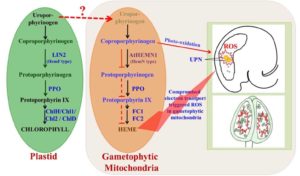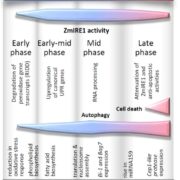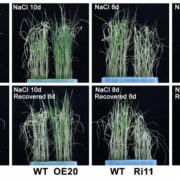Freeze-Thaw-Induced Embolism and Ultrasonic Emissions in Angiosperms
 All organisms including plants share the tetrapyrrole biosynthesis pathway that is critical for the production of compounds such as heme and chlorophyll. During tetrapyrrole biosynthesis, coproporphyrinogen III oxidase (CPO) catalyzes the conversion of coproporphyrinogen III into protoporphyrinogen IX. Pratibha et al. () report the results of the characterization of a mutation in the Arabidopsis gene At5g63290 that is orthologous to bacterial and mammalian CPO. As this gene shows greater homology with HemN-like CPO, they named it AtHEMN1. Loss of AtHEMN1 function increased coproporphyrinogen III level and reduced protoporphyrinogen IX level, suggesting the impairment of tetrapyrrole biosynthesis. Mutations that disrupted AtHEMN1 adversely affected silique length, ovule number, and seed set. Athemn1 mutant alleles could be transmitted via both male and female gametes, but homozygous mutants were never recovered. Embryo development in Athemn1 was arrested at the globular stage but the mutant phenotype was completely rescued by transgenic expression of AtHEMN1. Promoter and transcript analyses indicated that AtHEMN1 is expressed mainly in floral tissues and developing seeds. AtHEMN1-green fluorescent protein fusion protein was found targeted to mitochondria. Athemn1 mutant alleles also showed defects in gametophyte development, including nonviable pollen and embryo sacs with unfused polar nuclei. Improper differentiation of the central cell led to defects in endosperm development. Inactivation of any of the enzymes of the tetrapyrrole biosynthetic pathway leads to the accumulation of porphyrin compounds and causes cell death in plants through reactive oxygen species (ROS) production. As expected, the blockage of tetrapyrrole biosynthesis in the Athemn1 mutant also led to increased ROS accumulation in anthers and embryo sacs, as evidenced by nitroblue tetrazolium staining. Thus, it appears that that the tetrapyrrole/heme biosynthesis pathway operates in mitochondria and its impairment disturbs ROS homeostasis in flower buds, thereby adversely affecting male and female gametophyte development in Arabidopsis.
All organisms including plants share the tetrapyrrole biosynthesis pathway that is critical for the production of compounds such as heme and chlorophyll. During tetrapyrrole biosynthesis, coproporphyrinogen III oxidase (CPO) catalyzes the conversion of coproporphyrinogen III into protoporphyrinogen IX. Pratibha et al. () report the results of the characterization of a mutation in the Arabidopsis gene At5g63290 that is orthologous to bacterial and mammalian CPO. As this gene shows greater homology with HemN-like CPO, they named it AtHEMN1. Loss of AtHEMN1 function increased coproporphyrinogen III level and reduced protoporphyrinogen IX level, suggesting the impairment of tetrapyrrole biosynthesis. Mutations that disrupted AtHEMN1 adversely affected silique length, ovule number, and seed set. Athemn1 mutant alleles could be transmitted via both male and female gametes, but homozygous mutants were never recovered. Embryo development in Athemn1 was arrested at the globular stage but the mutant phenotype was completely rescued by transgenic expression of AtHEMN1. Promoter and transcript analyses indicated that AtHEMN1 is expressed mainly in floral tissues and developing seeds. AtHEMN1-green fluorescent protein fusion protein was found targeted to mitochondria. Athemn1 mutant alleles also showed defects in gametophyte development, including nonviable pollen and embryo sacs with unfused polar nuclei. Improper differentiation of the central cell led to defects in endosperm development. Inactivation of any of the enzymes of the tetrapyrrole biosynthetic pathway leads to the accumulation of porphyrin compounds and causes cell death in plants through reactive oxygen species (ROS) production. As expected, the blockage of tetrapyrrole biosynthesis in the Athemn1 mutant also led to increased ROS accumulation in anthers and embryo sacs, as evidenced by nitroblue tetrazolium staining. Thus, it appears that that the tetrapyrrole/heme biosynthesis pathway operates in mitochondria and its impairment disturbs ROS homeostasis in flower buds, thereby adversely affecting male and female gametophyte development in Arabidopsis.










Leave a Reply
Want to join the discussion?Feel free to contribute!